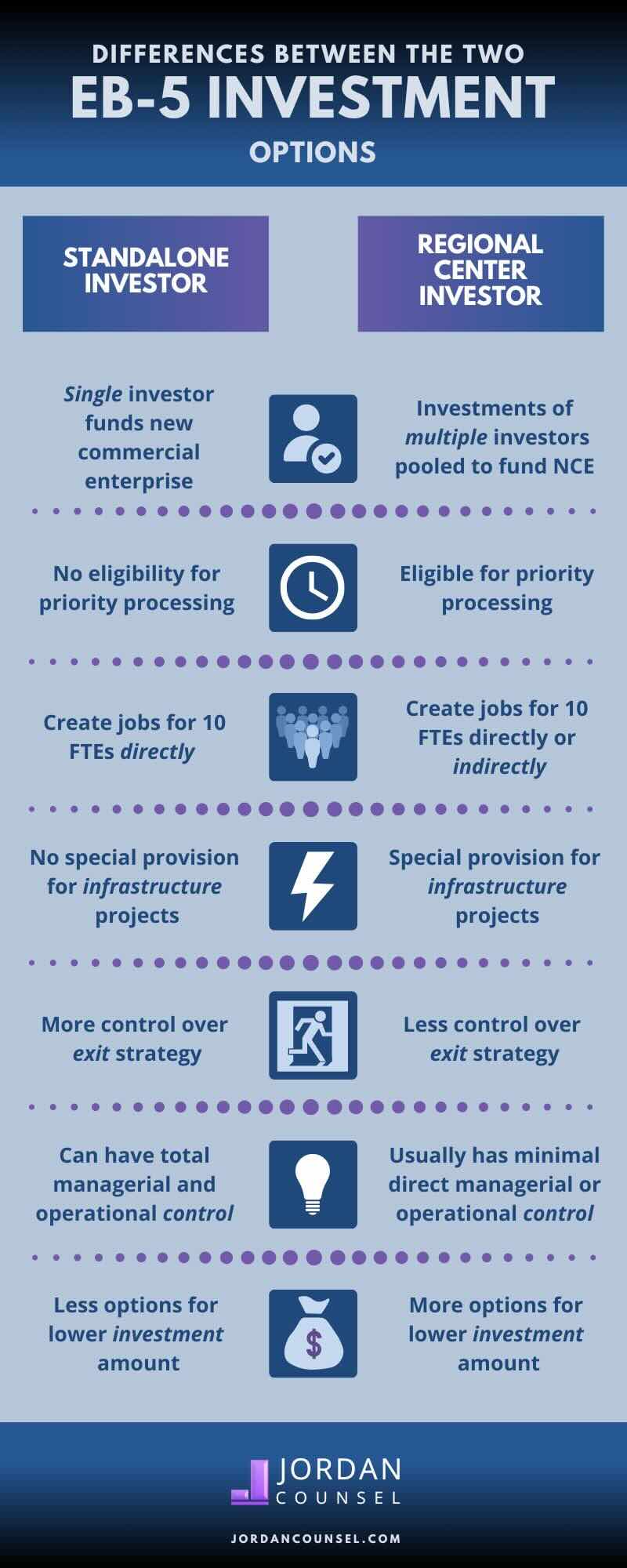What level of EB-5 Investment Amount is considered sufficient for approval
EB-5 Visa Explained: How to Get a Visa Via Investment
The EB-5 Visa program provides an one-of-a-kind opportunity for international investors looking for U.S. permanent residency through an organized financial investment technique. With certain eligibility criteria and financial investment thresholds, the procedure requires careful consideration and strategic planning. Understanding the nuances of the application process, including the distinctions between local facilities and straight financial investments, is vital for prospective candidates. As this path unfolds, prospective investors have to browse various benefits and difficulties that accompany it. What are the critical aspects that can influence the success of an EB-5 application?
Overview of EB-5 Visa
The EB-5 Visa program, designed to promote the united state economy through foreign investment, provides a pathway to long-term residency for qualified financiers and their families. Established by the Migration Act of 1990, the program aims to bring in international capital to develop tasks and improve economic growth in the USA. Capitalists that add a minimal total up to an accepted job can look for this visa, thus enabling them to purchase numerous industries, consisting of realty, facilities, and other business business.
The EB-5 program is particularly appealing because of its twin benefits: a chance for monetary rois and the potential for U.S. citizenship. By investing in targeted work locations (TEAs), which are defined as country regions or areas with high unemployment, capitalists may receive a minimized financial investment threshold. The program requires the production of at the very least 10 full time jobs for united state workers as a direct outcome of the investment. Effective applicants receive a conditional visa for two years, after which they can request long-term residency, provided they fulfill all program demands. This path has gathered attention from capitalists globally, making it a vital element of U.S. immigration plan.
Qualification Criteria
To get the EB-5 Visa, financiers must meet certain eligibility criteria that ensure their financial investment adds to job production and economic development in the USA - EB-5. First and leading, applicants have to invest a minimum of $1 million in a new business, or $500,000 if the investment is made in a targeted employment location (TEA), which is commonly identified by high joblessness or rural places
Furthermore, the enterprise should develop or preserve at the very least ten permanent tasks for qualifying U.S. employees within 2 years of the capitalist's admission to the United States. Financiers are additionally required to demonstrate that their investment funds were obtained via lawful means, giving evidence such as tax returns and financial institution statements.
One more essential requirement is that the financial investment needs to remain in a for-profit organization entity that was established after November 29, 1990, or one that has actually been restructured or expanded to satisfy the EB-5 requirements. Lastly, candidates must demonstrate their intent to actively participate in the organization, making certain that their involvement adds to its success. Meeting these eligibility requirements is vital for capitalists looking for to acquire permanent residency with the EB-5 program.
Financial investment Options
When thinking about the EB-5 visa, investors have to examine their options in between direct investment possibilities and local center programs. Each choice brings certain job production needs that are essential for satisfying the visa criteria. Comprehending these financial investment opportunities is necessary for making an educated choice that straightens with both financial goals and immigration goals.
Direct Financial Investment Opportunities
Direct financial investment chances under the EB-5 Visa program offer foreign capitalists with a path to get U.S. long-term residency while adding to the American economy. Unlike regional facility financial investments, straight investments require financiers to actively handle their organization endeavors within the united state, allowing for potential greater control and influence over their investment results.
To qualify for the EB-5 Visa via straight financial investment, international nationals need to invest a minimum of $1 million in a brand-new business or $500,000 in a targeted employment area, which is specified as a backwoods or an area with high unemployment. The financial investment should cause the production of a minimum of 10 permanent tasks for qualifying U.S. workers within two years.
Direct investment alternatives can differ extensively, encompassing industries such as realty advancement, production, friendliness, and technology start-ups. Investors have to carry out thorough due diligence to analyze the feasibility of their picked organization design and guarantee compliance with EB-5 regulations. Involving with monetary and legal specialists experienced in EB-5 matters is recommended to browse the intricacies of direct investment opportunities and make best use of the capacity for an effective application.
Regional Center Programs
Leveraging the EB-5 Visa program, local center programs use a streamlined financial investment avenue for international nationals seeking U.S. permanent residency. These programs are marked by the U.S. Citizenship and Migration Services (USCIS) and concentrate on pooling financial investments to fund different economic advancement projects, which may consist of real estate, facilities, and business ventures.
Investors generally add a minimum of $900,000 in targeted employment locations or $1.8 million in various other regions. EB-5. Among the primary benefits of local center programs is that they permit financiers to fulfill the EB-5 investment requirements through indirect job creation, instead of guide task production needed in straight investment opportunities
Regional focuses handle the investment in support of the investors, using a more easy approach than straight investment. This administration includes supervising job growth, monetary coverage, and compliance with USCIS regulations. In addition, local centers usually have actually established performance history, improving the confidence of possible capitalists.
Inevitably, regional facility programs provide an engaging choice for those seeking to navigate the complexities of the EB-5 Visa process while contributing to U.S. financial development and task production.
Job Production Requirements
To receive an EB-5 Visa, capitalists have to confirm that their capital expense leads to the creation of a minimum of 10 permanent work for U.S. workers within two years. This task creation need is an important element of the EB-5 program, created to promote the U.S. economic climate and advertise financial development.
Capitalists can select between 2 key investment options: direct financial investments and investments through Regional Centers. With direct investments, the capitalist has to proactively handle business and guarantee task production, while additionally demonstrating that the jobs created are for united state citizens or authorized permanent citizens. On The Other Hand, Regional Center financial investments permit capitalists to merge their sources right into a designated job, typically resulting in indirect job development, which can be counted in the direction of satisfying the job need.
To efficiently fulfill the job production standards, it is essential for financiers to function very closely with seasoned professionals that can lead them through the complexities of the EB-5 program. Correct preparation and adherence to guidelines are important to confirm conformity and safeguard a course to long-term residency. Failing to meet these task creation needs can endanger the financier's EB-5 application and their immigration standing.
The Application Process
The application process for the EB-5 visa includes a series of necessary steps and specific qualification requirements that candidates should fulfill. Comprehending these criteria is crucial for a successful application. This area will certainly detail the needed certifications and provide a step-by-step overview to guiding via the procedure.

Eligibility Demands Review
Recognizing the qualification requirements for the EB-5 visa is essential for prospective investors aiming to obtain permanent residency in the United States. To certify, a specific should demonstrate a minimal investment of $1 million in a brand-new company, or $500,000 if the investment is made in a Targeted Employment Location (TEA), which is defined as a backwoods or one with high joblessness.
Furthermore, the financier should show that the financial investment will certainly preserve or create a minimum of 10 full-time tasks for united state workers within 2 years of the financial investment. The venture has to likewise be a for-profit entity and needs to be freshly established or significantly remodeled if it is an existing business.
The applicant has to prove that the financial investment funds are gotten with authorized ways, consisting of individual savings, gifts, or car loans sustained by appropriate documents. On top of that, the investor should proactively take part in the business, ensuring their involvement in the administration of the business. Satisfying these qualification requirements is essential for a successful EB-5 application and eventually securing a permit via this investment method.
Step-by-Step Procedure
As soon as eligibility needs are met, potential financiers can start the application process for the EB-5 visa. The very first step includes finishing Type I-526, the Immigrant Request by Alien Financier. This form has to be come with by sustaining documentation that shows the financier's certifying financial investment and the development of a minimum of 10 permanent jobs for U.S. workers.
Upon authorization of Kind I-526 by the USA Citizenship and Immigration Provider (USCIS), capitalists can request the EB-5 visa via either consular handling or modification of condition, relying on their current residency. For those outside the united state, this indicates submitting a visa at an U.S. consulate. On the other hand, if currently in the U.S., applicants need to submit Type I-485, Application to Register Permanent Home or Change Standing.
After approval, investors and their eligible relative obtain conditional permanent residency for two years. Within 90 days prior to the expiration of this conditional status, investors have to submit Type I-829, Request by Business Owner to Get Rid Of Conditions, to get irreversible residency. Effective completion of this action wraps up the EB-5 investment process, approving the financier a Visa.
Regional Centers vs. Direct Investments
Maneuvering the EB-5 visa program entails a crucial decision between direct investments and regional facilities, each offering distinct pathways to getting irreversible residency in the United States - Form I-526. Regional facilities are designated by the USA Citizenship and Migration Services (USCIS) to promote economic development via job development. When investing through a regional facility, investors usually add to a pooled fund, which is handled by the facility. This alternative frequently enables a more passive investment approach, as the facility looks after the task and task creation needs
On the other hand, direct investments require financiers to actively manage their own organization ventures in the United States. This strategy necessitates a more hands-on involvement, as the capitalist must create and sustain at least ten full time tasks straight pertaining to their company. While straight investments might supply greater control over the financial investment outcome, they likewise require higher obligations and dangers.
Eventually, the choice between straight investments and local centers rests on specific threat tolerance, wanted involvement degree, and financial investment goals. Comprehending these distinctions is essential for capitalists looking for to navigate the complexities of the EB-5 visa program effectively.
Advantages of the EB-5 Visa
The EB-5 visa program offers countless advantages for foreign investors looking for long-term residency in the United States. Among one of the most considerable advantages is the chance for financiers and their immediate household members, including partners and kids under 21, to acquire a permit, granting them the right to live and function in the united state indefinitely.
The EB-5 program does not call for a sponsor, permitting capitalists better freedom in their immigration trip. This program additionally offers a pathway to citizenship after five years of permanent residency, assisting in long-lasting stability for families. Furthermore, spending through marked Regional Centers can be less troublesome, as these entities typically take care of the job and work creation requirements on part of the capitalist.
The EB-5 visa can lead to substantial financial returns, as investments are typically directed towards industrial enterprises that can generate revenues. By adding to financial growth and work creation in the U.S., EB-5 financiers play a crucial duty in improving regional neighborhoods. Generally, the EB-5 visa acts as a compelling choice for those seeking to protect a future in the United States while making a positive impact.
Common Obstacles and Factors To Consider
While the EB-5 visa program provides attractive advantages for foreign capitalists, it additionally includes its share of obstacles and considerations that potential candidates ought to very carefully assess. One significant challenge is the financial commitment entailed, as the minimal investment quantity is substantial, commonly established at $1 million or $500,000 in targeted employment locations. Investors need to assure that they have enough capital and a clear understanding of the linked dangers.

Potential capitalists should carry out thorough due persistance on the investment projects to prevent deceptive schemes. The success of an EB-5 application pivots on the creation of at the very least 10 full-time tasks for united state workers, requiring careful preparation and monitoring of business's efficiency (EB-5 Investment Amount). Ultimately, steering these obstacles requires a strategic strategy and commonly the guidance of knowledgeable specialists in immigration and financial investment law
Often Asked Concerns
How much time Does the EB-5 Visa Process Commonly Take?

Can Household Members Apply With the Key EB-5 Applicant?
Yes, household members can use along with the main candidate. EB-5 Visa by Investment. Eligible dependents usually include partners and single children under 21, enabling them to get eco-friendly cards contingent upon the key candidate's effective visa authorization
What Occurs if My Investment Fails?
It may jeopardize your immigration condition and the possibility for acquiring an environment-friendly card if your financial investment More about the author stops working. It's important to perform comprehensive due persistance and think about danger mitigation methods prior to continuing with any type of investment.
Exist Age Restrictions for EB-5 Investors?
There are no details age constraints for EB-5 capitalists; nonetheless, the private have to go to least 18 years old to legitimately enter into financial investment contracts. Minors may certify via adult financial investment and sponsorship.
Can I Travel Outside the U.S. Throughout the Application Process?
Taking a trip outside the united state during the application procedure might affect your status. It is recommended to consult with a migration lawyer to understand prospective threats and warranty conformity with all requirements while your application is pending.
Regional centers take care of the financial investment on behalf of the investors, offering a much more easy method than direct financial investment. To qualify for an EB-5 Visa, investors have to verify that their capital investment results in the development of at least ten full time tasks for U.S. employees within 2 years. Capitalists can select in between 2 primary investment alternatives: direct investments and investments with Regional Centers. The investor must reveal that the financial investment will create or maintain at the very least ten permanent tasks for U.S. workers within two years of the investment. Eventually, the choice in between straight investments and local facilities hinges on individual risk resistance, preferred participation level, and investment objectives.